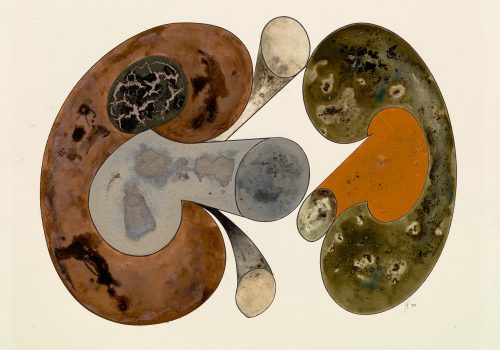The exhibition was fantastic. It was at Pace Gallery in New York, organized with Pace/MacGill and titled Irving Penn: Paintings.
Penn, like Cartier-Bresson and Bourdin dreamed of being a painter. We can only rejoice at these failed vocations and their migrations to photography. Henri Cartier-Bresson and Guy Bourdin destroyed their first paintings, Penn did the same. The only survivors of these early works are a group of drawings and, later on, Penn never exhibited his paintings. The Penn Foundation has not only decided to show them but has created a great catalog. It is to this discovery that we are dedicating the day. In this first article, Peter MacGill gave us his text on Irving Penn.
Jean-Jacques Naudet
That Irving Penn left us with a relatively unknown body of work should be of no surprise whatsoever, nor should the fact that he actually invented a way of making his paintings. In my twenty-two years of working closely with Mr. Penn, I had no idea that this remarkable, robust and diverse body of work sat in his studio drawers. He talked about his paintings and he shared a few in various publications over the years, but many of us who knew him well actually had no idea of the power, the extent of the work.
As with many great artists, a seeming impossibility becomes their starting point. With most of these paintings, Penn began with a sketch which was then enlarged and produced as a platinum print upon which he could work. Proceeding this way, Penn introduced scale and his beloved platinum printing process into his painting methodology.
Penn’s paintings consist of a variety of materials and techniques. In a sense, the lines in platinum metals become the boundaries within which Penn painted in ink, watercolor, sand, gum arabic, and graphite. Once the line was drawn, Penn was free of the constrictions he might have faced when making photographs. Not that he wasn’t free to invent every time he opened his shutter, but with his camera, light did the drawing. With his paintings, his hand did the drawing, and no matter the discipline, Penn’s mind always played a large part in the making of his work.
These paintings are inventions, both technical and aesthetic, but isn’t that what the great artists do? Think of Schwitters, Morandi, Malevich, Léger and so many more. Think of the moment when Picasso and Braque introduced the jittery effect of the hand-cranked cinema projector into their work as they were expanding the possibilities of Cubism. Great art invents new ways of moving us.
We know that Penn created a seismic shift with his photographs, many of which were made for the printed page. That his work done in private, in his spare time (I’ve always wondered how this man could have any spare time), could also transform the visual world is yet another gift Penn left behind for us to ponder.
Peter MacGill
















